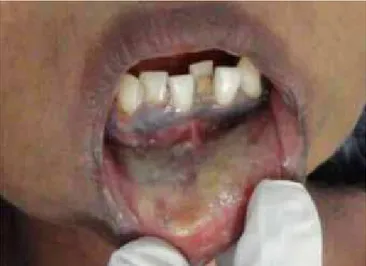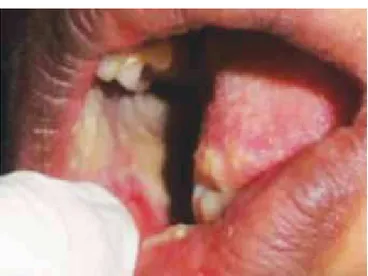MM Mini et al
636
Uremic Stomatitis: Report of Two Cases
1MM Mini, 2Twinkle S Prasad, 3Valsa ThomasABSTRACT
Uremic stomatitis is a rarely reported oral mucosal disorder associated with renal disorder. In this article, we are reporting two cases who had chronic renal disorder, also review in detail about the current knowledge of oral and dental aspects of renal failure and there treatment modalities.
Keywords: Renal failure, Uremic stomatitis, pseudomembrane. How to cite this article: Mini MM, prasad TS, Thomas V. Uremic Stomatitis: Report of Two Cases. Oral Maxillo fac pathol J 2015;6(2):636-638.
Source of support: Nil Conlict of interest: None
INTRODUCTION
Uremic stomatitis is a rarely reported oral mucosal dis order possibly associated with longstanding uremia in chronic renal failure patients. It was irst mentioned by Etienne Lancereaux in 1887 and described by Barié in 1889.1 With impaired renal function, a decrease glomeru lar iltration rate (GFR), and accumulation and retention of various products of renal failure changes the oral cavity progressively through an azotemic to a uremic state. In studies of renal patients up to 90% were found to have oral symptoms of uremia.2 There have been only a few number of relevant reports noted in the literature. In this article, two case reports of uremic stomatitis with diffe rent clinical features are mentioned.
CASE REPORTS
Case 1
A 35yearold female was referred here for severe burning sensation in mouth since 1 week. She also complained of dysgeusia since 2 months, was continuous and had no notable initiating or precipitating features.
OMPJ
case rePOrt
10.5005/jp-journals-10037-1055
1Senior Resident, 2Assistant professor 3
professor and Head
1,3Department of Oral Medicine and Radiology, Government Dental College, Thiruvananthapuram, Kerala, India
2
Department of Oral Medicine and Radiology, Government Dental College, Kottayam, Kerala, India
Corresponding Author: MM Mini, Senior Resident, Department of Oral Medicine and Radiology, Government Dental College Thiruvananthapuram, Kerala, India, e-mail: minibabueaden@ gmail.com
The patient was married (housewife) and had an abortion 1 year back spontaneously at 2 months of gestation. She also had a history of fever with cough, severe headache with vomiting, exertional dyspnea since 2 months. She was diagnosed as chronic renal disease due to glomerular nephritis associated with severe hypertension and grade 4 hypertensive retinopathy. Extraoral examination revealed pallor, fatigue, hyperten sive 210/110 mm Hg, uremic oral malodor. There was no cervical lymphadenopathy, and the cranial nerves were grossly intact. Intraoral examination revealed adherent white plaques of the loor of the mouth, buccal mucosa, labial mucosa, lateral borders of the tongue and gingivae (Figs 1 to 3). Very poor oral hygiene with genera lized periodontitis. On investigation, Hb—8.6 gm/dl, BUN 72.8 mg/dl, creatinine—10.13 mg/dl, S sodium—133.5
Fig. 1: Case 1: uremic frost on lower labial mucosa
Uremic Stomatitis: Report of Two Cases
Oral and Maxillofacial Pathology Journal, July-December 2015;6(2):636-638 637
OMPJ
3 days. White lesion and ulcers completely resolved after 3 weeks while the renal parameters of the patients were still elevated (Fig. 5).
DISCUSSION
Uremic stomatitis represents a relatively uncommon intraoral complication seen, mostly, in cases of endstage renal disease or undiagnosed/untreated chronic renal failure.
Etiology of this remains unknown although it has been suggested that it may be due to raised levels of ammonia compounds.3 Ammonia is formed through the action of bacterial ureases modifying salivary urea which may be raised in affected individuals.4 It has been suggested that stomatitis appears when blood urea levels are higher than 300 mg/ml,5 although some cases reported mucosal changes at urea levels of less than 200 mg/ml.6,7 In our cases, 72.8 mg/dl and 102 mg/dl were found respectively (normal range—8-18 mg/dl), also, as a chemical burn or as a general loss of tissue resistance. Other possible causes include hemorrhagic diathesis,
Fig. 4: Case 2: Pseudomembranous uremic frost on left side buccal mucosa
Fig. 3: Case 1: Pseudomembranous frost on buccal mucosa
Fig. 5: Case 2: Post-treatment view mmol/l, S potassium—5.7 mmol/l, HIV and hepatitis B
were negative. In view of the extensive nature of the oral lesions, uremic stomatitis was judged to be the working diagnosis; in differential diagnosis chronic hyperplastic candidiasis were considered.
The patient was treated with analgesics, antibio tics (tetracycline), 100 mg clotrimazole, chlorhexidine mouthwash and followed up every 3 days. Patient was also advised to maintain a proper oral hygiene lesion gradually subsided after 1 week which then the patient underwent renal dialysis. Completely resolved after 1 more week while the patient was still continuing the topical medications.
Case 2
A 49yearold male patient came with a complaint of ulceration on tongue since 1 week. He was under treatment for pyelonephritis since 10 years. On ex amination, he was moderately build and nourished. Intraoral examination revealed mucosa on the left side involving ventral, lateral surface of tongue, gingival and buccal mucosa were covered with a thick exu dates and pseudomembrane (Fig. 4). Also, an ulcer of size 2 × 2 cm on left posterolateral border of tongue covered with a pultaceous coat. On investigation Hb— 10.6 gm/dl, creatinine—15.13 mg/dl, S sodium—120.5 mmol/l, S potassium—3.6 mmol/l, BU—102 mg/dl, HIV and hepatitis B were negative. Diagnosis of uremic stoma titis were made differential diagnosis of traumatic ulcer and chronic hyperplastic candidiasis were considered.
MM Mini et al
638
common in uremia, causing decrease of viability of the affected tissues allowing bacterial infection, which can result in ulceration and pseudomembrane formation.8
Four forms are recognized: ulcerative form, hemorr-hagic form, nonulcerative pseudomembranous form and hyperkeratotic form.9 Last two forms are commonly seen and appear as white lesions. The hyperkeratotic form presents as multiple, painful white keratotic lesions with thin projections. Nonulcerative form may appear as erythemopultaceous form characterized by red mucosa covered with a thick exudates and a pseudomembrane. In these reported cases, irst case was consistent with hy perkeratotic form and the second case had both ulce rative and nonulcerative pseudomembranous form. Tongue and loor of mouth are usually affected.
Other clinical features include xerostomia, uriniferous breath odor, unpleasant taste and a burning sensation. Oral complications also include candidiasis, viral and bacterial infections.
Diagnosis is based upon history, clinical feature and lab investigations, like blood urea level, renal function test and urinalysis.
Uremic stomatitis is a disease entity that requires both local and systemic therapy. The primary emphasis is directed toward the correction of the systemic patho logy for proper resolution of the oral condition. Although it will subside after renal dialysis local treatment inclu ding mild acidic mouth rinse, such as dilute hydrogen peroxide, topical antimicrobials and topical anesthetics,
such as lidocaine for pain control. Proper maintenance of oral hygiene can improve the conditions.
Chronic renal failure has become common in present days due to the changes in lifestyle. A thorough under standing of oral manifestation associated with renal dis eases is necessary for an oral physician to help the patients in need often lifethreatening conditions at an early stage. Role of dentist may be pivotal as he may the irst person to diagnose such patients, so, it is important to familiarize the oral manifestations of renal diseases and advice them with the importance of proper oral hygiene maintenance.
REFERENCES
1. Barié E. De la stomatite uremique. Arch Gen Med 1889;2:
415432.
2. Greenberg MS, Glick M, Ship JA. Burket’s oral medicine.
11th ed; 2008.
3. Carlin RT, Seldin R. Oral ulcerations associated with uremia. report of a case. NY State Dent J 1969;35:211-214.
4. Bliss S. The cause of sore mouth in nephritis. J Biol Chem 1937;121:425-427.
5. Gruskin SE, Tolman DE, Wagoner RD. Oral manifestations of uremia. Minn Med 1970;53:495-499.
6. Carlin RT, Seldin R. Oral ulcerations associated with uremia: report of a case. NY State Dent J 1969;35:211-214.
7. Bereston ES, Keil H. Membranous stomatitis associated with debilitation and uremia. Arch Dermatol 1941;44:562-570. 8. McCreary CE, Flint SR, McCartan BE, et al. Uremic stomatitis
mimicking oral hairy leukoplakia: report of a case. Oral Surg Oral Med Oral Pathol Oral Radiol Endod 1997;83:350-353. 9. Laskaris G. Treatment of oral disease: a concise textbook.

